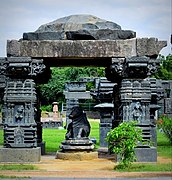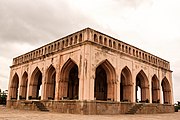Architecture of Telangana
The Architecture of Telangana dates back thousands of years.
Medieval period
Chalukya
The 7th-century Navabrahma Temples at Alampur were built by the Badami Chalukayas.
Kakatiya

The Warangal Fort, Ramappa Temple, Kota Gullu and Thousand Pillar Temple are the best examples of Kakatiya architecture.[1][2]
Golconda Sultanate

The architecture of the Golconda Sultanate is very similar to that of other Deccan Sultanates. This Indo-Islamic style is unique to the states of Telangana, Karnataka and Maharashtra. The ruins of the Golconda Fort is the earliest example.[3][4] They built elaborate tombs and mosques out of mortared stone.
The 16th-century Charminar, a centerpiece of Hyderabad, is a mosque with four minarets at four corners, elaborately decorated with stucco work. It stands at the confluence of four roads. It overlooks the Mecca Masjid, one of the largest mosques in India.
The Qutb Shahi tombs at Hyderabad contain the tombs of the sultans, other royals and important noblemen. Other examples include the Toli Mosque, Khairtabad Mosque and Taramati Baradari.
Early Modern period
During the British colonial period, Telangana was ruled by the Nizams of Hyderabad. The seat of the Nizam was Chowmahalla Palace, which showcases a wide variety of Indian and European styles. The British Residency in Hyderabad built in the neoclassical style is another great example of this period.
The High Court, City College, Osmania General Hospital and Kacheguda Railway Station in Hyderabad were designed by British architect Vincent Esch in the Indo-Saracenic style of architecture.
Post-Independence
This section is empty. You can help by adding to it. |
Gallery
-
One of the Alampur Navabrahma Temples built by Chalukya Empire between the 7th and 10th centuries.
-
A mandapam at the ruins of the Warangal Fort. The fort was destroyed by the Delhi Sultanate in 1323.
-
Charminar was built by the Golconda Sultanate in the 16th century.
References
- ^ Law, John. Modern Hyderabad (Deccan). pp. 13–14.
- ^ Centre, UNESCO World Heritage. "The Glorious Kakatiya Temples and Gateways". UNESCO World Heritage Centre. Archived from the original on 2018-04-03. Retrieved 2018-12-19.
{{cite web}}: Unknown parameter|dead-url=ignored (|url-status=suggested) (help) - ^ Haig, Wolseley (1907). Historic landmarks of the Deccan. University of California Libraries. Allahabad, Printed at the Pioneer Press. pp. 180–208.
- ^ Centre, UNESCO World Heritage. "The Qutb Shahi Monuments of Hyderabad Golconda Fort, Qutb Shahi Tombs, Charminar". UNESCO World Heritage Centre. Archived from the original on 2018-02-01. Retrieved 2018-12-19.
{{cite web}}: Unknown parameter|dead-url=ignored (|url-status=suggested) (help)





